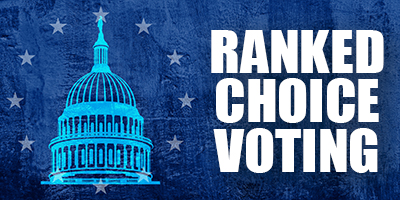
Six-in-Ten Favor Ranked Choice Voting in Federal Elections
Based on an in-depth survey, 61% of voters favor using ranked choice voting in general federal elections, including 73% of Democrats and 55% of independents. Republicans are divided, 49% in favor and 50% opposed. The survey of 1,296 voters was conducted by University of Maryland’s Program for Public Consultation.
Ranked choice voting is a method that seeks to make it more possible for independent and third party candidates to compete in elections. It has been proposed for federal elections in the Fair Representation Act (H.R. 3863). More than 50 jurisdictions have used or plan to use ranked choice voting in their local elections, including New York City. Maine and Alaska have decided to use it in federal elections.
“American voters are frustrated with the partisan polarization in American democracy but are often afraid of voting for independent or third party candidates because they do not want to effectively throw away their vote,” commented PPC Director, Steven Kull. “Ranked choice voting is appealing as a way to solve this conundrum.”
In ranked choice voting, when there are more than two candidates, voters not only select their first choice but can also rank candidates by preference. Then, if none of the candidates get a majority–like in a runoff scenario–the candidate with the lowest number of votes is eliminated. Voters who favored the eliminated candidate have their votes switched to their second choice (if they made one). The tally is then recalculated and the candidate with a majority of votes is the winner. If there are more than three candidates, the process is repeated until there is one candidate with a majority of votes counted.
To ensure that respondents understood the issue, they were given a briefing on the proposal and evaluated the prevailing arguments for and against. The content was reviewed by proponents and opponents to ensure that the briefing was accurate and balanced, and that the arguments presented were the strongest ones being made. Both arguments for and against were found convincing by majorities, but the arguments in favor were found convincing by larger majorities.
PPC conducted a congressional district analysis by dividing the sample six ways, based on the partisan orientation of respondents’ Congressional district according to Cook’s Political Report PVI ratings. Majorities in all types of districts are in favor of ranked choice voting in congressional elections from very red 56% to very blue 63%.
While Republicans as a whole were divided, less than half of Republican men were in favor (46%), while a modest majority of women were in favor (54%). Support increased with educational level: just four-in-ten Republicans with a high school education were in favor (41%), those with a college degree were divided, and among those with a postgraduate degree a majority favored (55%).
The survey was conducted online from July 13- September 15, 2021 with a national probability-based sample of 1,296 registered voters, provided by Nielsen Scarborough from Nielsen Scarborough’s sample of respondents, who were recruited by mail and telephone using a random sample of households. The margin of error was +/- 2.7 percent.
- Questionnaire with Frequencies: https://publicconsultation.org/wp-content/uploads/2022/04/RCV_Quaire_0422.pdf
- Full Report: https://publicconsultation.org/wp-content/uploads/2022/04/RCV_Report_0422.pdf
- Take the survey yourself: https://survey.alchemer.com/s3/6781592/rcv


Be the first to comment